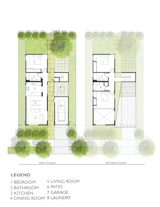Vibrant Affordable Housing Prototypes in Los Angeles
According to a 2014 report by the National Low Income Housing Coalition, a family would have to work more than three minimum wage jobs to afford the average rent for a two-bedroom apartment in Los Angeles. A staggering fact, but it's the everyday reality for denizens in one of the most populous cities in the United States and similar to the aggressive real estate markets in other metropolitan areas. Lehrer Architects, a multi-disciplinary practice based in Silver Lake, and Restore Neighborhoods L.A., or RNLA, have devised a series of three prototype houses to help alleviate the situation.
The challenge set forth by RNLA was to create three-bedroom, two-bathroom single-family homes that could be built on typical lots—meaning narrow—in South Los Angeles with a construction budget of $250,000, or roughly $165 per square foot.
Working with a construction budget of $165 per square foot, the architecture firm accommodated three bedrooms and two bathrooms in each of the designs and sought to instill the spaces with the elements not typically associated with affordable housing. "With good, thoughtful design, this category of residences does not have to have an expected, underwhelming look," Michael Lehrer, the firm's president and founder, says. "Just call it gracious housing with emblems of luxury: ample natural light; views; generous indoor-outdoor relationships; processional spaces; and an open, trusting, and welcoming attitude to the street."
"Many of these neighborhoods have really good housing stock: modest homes with good bones, porches, traditional floor plans, and front and back yards—the basic ingredients of the American dream," Michael Lehrer, president and founder of Lehrer Architects, says. "Our work is to respect what is there and ennoble it, particularly in the mindset of the people who live there. The value of respectful, fresh architecture is that it lets people know that their neighborhood is alive, healthy, and optimistic about the future."
To that end, Lehrer and his team sought to create homes that embodied the tenets of modern design using a toolkit of light, space, proportion, and color to forge luxurious-feeling structures.
The houses, like the 53rd Street Prototype, feature lean and gracious walkways to the front door. "Though these prototypes are set in economically challenged neighborhoods of South Los Angeles, their design provides for integrated defensible space while maintaining openness and connection to the outdoors," states the project description.
"We wanted to do something other than the usual affordable housing solution which likely fuels the less-than-flattering association with housing for lower-income earners," Nerin Kadribegovic, a principal at Lehrer Architects, says. "Our goal was to see how our design approach could also positively affect the neighborhoods."
Each of the houses features generously day-lit spaces; indoor-outdoor living, a hallmark of Southern California residential design; high ceilings and open rooms; vibrant colors; privacy; and a form that respects the existing urban fabric. Efficiency dictated the overall design. For example, the architects organized the floor plans so plumbing would be located in a central stack, thereby reducing the amount of piping specified. They also optimized the roof pitch and site drainage to help keep long-term maintenance down. Daylighting and cross-ventilation reduce electricity use and the building materials are durable and hardy. A drought-tolerant landscape requires little upkeep.
While the designs tackle challenges in lot sizes in South Los Angeles, they could be modified for nearly any single-family urban neighborhood.
"The sites were extremely constrained; a circumstance we really welcomed," Lehrer says. "While some streets were in better shape than others, the basic urban housing fabric is intact. Our work is precisely to respect the existing fabric, understanding typology and what makes the streets coherent. Just blending in seamlessly would neither honor nor energize the street. It required some invention, palpable freshness and optimism." The 99th Street house is shown here.
"It exemplifies our definition of architecture: The shaping of space, using objects in light to create practical and emotive places," Lehrer says. "We design homes for everyone from the homeless to the well-homed. We recently finished a design that cost about 100 times more than the budget allotted for the RNLA project but it is the same architectural parti/concept. It reminds us that architecture is architecture and people are people...and the basic truths are universal irrespective of the social ladder."
"Color simply and cost-effectively enriched and made the architectural idea palpable and pleasurable," Lehrer says about the prismatic theme. "It was used to explicitly articulate and dramatically enhance the circulation and spatial concepts. It helps make modest, but wonderful, spaces a little magical."
The 99th Street plan is shown here. "Layouts were driven by the most basic design principles: hyper-efficient floor plans that minimize circulation with singularly-located plumbing stacks," Lehrer says. "The roof slope and roof-site drainage was also made as simple as possible. The continuum of public to private space was carefully orchestrated."
Published
Last Updated
Get the Dwell Newsletter
Be the first to see our latest home tours, design news, and more.










